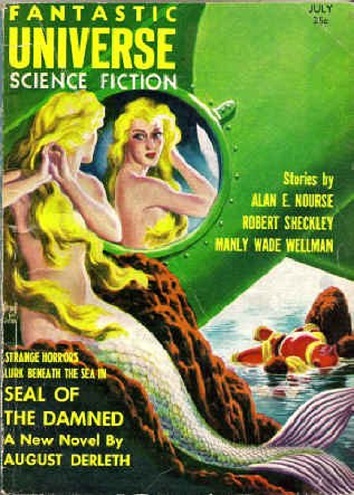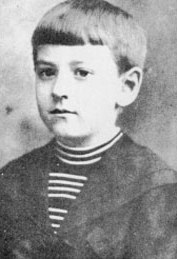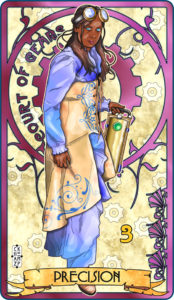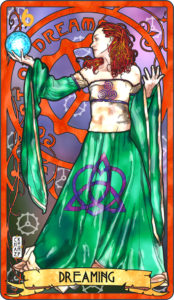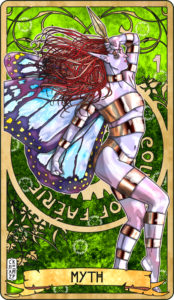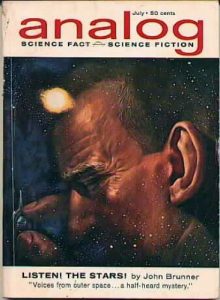In my best Harry Carey voice: “Holy Cow!”
This is what a 10 out of 10 issue is like. Incredible issue for a variety of reasons. The stories were great, the ads were fun and interesting, and the science essay was, well, astounding.
Table of Contents: http://www.isfdb.org/cgi-bin/title.cgi?136693
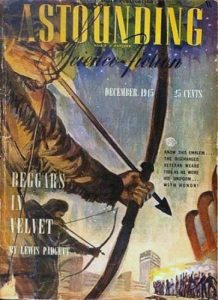
Inside the front cover of this issue are a couple of ads, one of which has the tag line of “Making Your Wishes Come True” (1). The text begins with: “One wish has been fulfilled. Won by 3.5 years of deadly struggle.” It’s an ad to continue buying victory bonds.
If I needed a reminder when this issue was published, I got it right here. It’s the December, 1945 issue, and that matters during the rest of this issue.
The first article is the John W. Campbell’s editor column called Atoms Won’t Do Everything. This column talked about the possibilities of atomic power other than the bomb, at the point of writing this essay merely 3-4 previous. It’s got some surprising technical details, such as how to arrange the pile with either heavy water or graphite. The information is readily available now, but in 1945? I was surprised.
The next story, again only 3-4 months after the bombs were dropped, was a story by Lewis Padgett called Beggars In Velvet. Padgett is, as some of you probably already know, is the pseudonym used by Henry Kuttner and C.L. Moore for their collaborations.
Beggars in Velvet is one of 6 Baldy stories about a mutation to humanity after a nuclear war. In it, a portion of humanity has mutated to have telepathic powers.
The war has splintered the remainder of humanity into a series of city-states who actively work to keep themselves separated. The concept of gathering together in large polities seems like something that caused the big war, though they regularly trade among themselves. There are also tribes called Hedgehounds, who have taken this concept of decentralization and become nomads. Add to this societal change a portion of the population that has telepathic powers and you’re guaranteed to have trouble.
The Baldies, the ones with telepathic powers, are split into two factions. One is trying to coexist and prevent any sort of pogrom. The other, the paranoids, are trying to promote a war where they can eliminate the lesser version of humanity.
This world-building has great potential for stories, and Kuttner and Moore don’t waste it. The main hero, Burkhalter, fights against Barbara Pell, a paranoid, to prevent everything from going to hell in their city-state of Sequoia. Also, the Mutes, the ruling class of the non-paranoid Baldies, are working alongside to keep the lid on the kettle.
Burkhalter is a good man and hates everything that the paranoids stand for. Desperately, he continues the fight, doing all he can to stop Barbara and her allies. However, despite their best efforts, the paranoids succeed in starting a nightmare that might end up sweeping the world in fire and terror.
In the end, with some desperate measures employed by, Hobson, the Mute leading the battle and successful long-laid plans to get the Hedgehounds on their side, the Baldies defeat the paranoids. The Hedgehounds are the ones with bows and arrows staring down the city folk on the cover, by the way.
However, the story isn’t over. You see, Burkhalter may hate and loathe what the paranoids think, but yet he still falls in love with Barbara. He doesn’t know it for much of the story, but the Mutes recognize this in his emotions. Someone who can empathize enough with a paranoid to fall in love with one must then be a latent paranoid. He is what he hates.
But he’s only a latent paranoid. If he has constant help, that transition could be avoided. That’s when we find out *all* of the Mutes are latent paranoids and they are in constant contact with each other, helping each one not to stray.
Man, what a good ending. The story lacked some zing because it’s not an uncommon type of “not-our-kind” conflicts, but the ending gives so much ooomph to the decisions of the Mutes and of Burkhalter. This is a character I want to see again. I’ll look for him in the later Baldy stories, because this is good stuff.
Next is the story Orders by Malcolm Jameson. In this story, the war across the Solar System is over. The ships are getting mothballed. Those needing repair or maintenance lack parts and money to pay for labor. Yet again, I mention how this story was published in December of 1945, but he himself died on 16 April, 1945. He is anticipating the end of the war, but I suspect he is remembering the end of World War One as well.
The treaty that ends the war has all the idealistic hopes and lack of reality built in to the Treaty of Versailles. Side note, Jameson was a naval officer and 28 or so in 1919. I don’t know if he was still in the Navy, but he certainly had some interest in the Treaty. Anyway, the treaty in this story outlaws war and in fact, outlaws any kind of threatening behavior. A ship captain couldn’t, for example, threaten any kind of force to comply a criminal to go to jail.
And that’s exactly the story here. A criminal is in the asteroids. The Terran government is asking for him to be extradited, but the government, such as it is, of the asteroids merely laugh at them. The diplomat who added the relevant clauses in the treaty drops the problem on Bullard’s lap, hoping the war hero can at least take the blame.
It’s a Retief-like problem. A bureaucrat with no idea how things actually work outside of his theoretical construct has no idea how to fix a problem when someone refuses to work within that construct. Knowing he can’t possibly be at fault, he dumps the problem, and therefore the blame, on someone else. He tells Bullard to get the criminal or else, but absolutely forbids him to use any hint of violent behavior or threats. No guns allowed. No weapons at all.
And yet, Bullard manages to pull it off.
How? Well, he sends his most capable officer with an unarmed ship and sealed orders. The officer goes to the asteroids and asks for the criminal. They say no. He goes back to the ship and waits. He’s been told to wait four hours, then open and execute the sealed orders. What’s in the orders nobody knows.
Just before the deadline, the criminal is delivered to the officer. The reputation of Bullard and the impending opening of the orders is enough to convince the other government to send the criminal over.
When the officer returns and the criminal is put away, he asks Bullard about the orders. He opens them and hands them to the officer. His orders, after waiting for four hours, were to “Return to Base” (59).
One of the joys of reading these magazines is stumbling upon something I should have read years ago but never stumbled across before. This is one of those. Orders is a story about John Bullard, in fact the last of them written. It was found among his papers after his death. This is early mil-SF and I am definitely getting the e-book collection of these stories.
At the end of this story is a Gillette ad. Gillette razors, after all, have “The swellest low-priced blade it town” (59).
The next story is a treasure. It’s part II of The Mule from Isaac Asimov. Yes, this is The Mule that’s a part of the Foundation series. I’m not going to explain the story here, because if you haven’t read the entire Foundation series, you should.
What’s exciting to me is that I have now seen the first published version. I didn’t notice any difference from the version I first read it, the 1966 Avon printing, but I suspect there might be. If there are, they’re formatting/typo changes, as it’s the same story.
As much of a treasure as it is to find the first printing of a Foundation story, the science essay immediately following is perhaps even greater. It’s a series including technical details of the creation of the atomic. It includes photos from the Trinity detonation from 16 July, 1945 and some photos from Hiroshima.
As for particular details, it covered just about everything it could that wasn’t classified. I again feel obligated to mention this was published in December of 1945, or about four years before the Soviets have their first successful detonation.
From a historiographical perspective, this is something someone researching the early atomic era would probably find riveting. I sure did. It’s also interesting to realize that this might very well have been the first time some of these details had been published. I don’t know that for sure, but it’s certainly a reminder of the speed of information dispersal then and now.
The next story is Trouble Times Two by George O. Smith. It’s about a schizophrenic with two useful personalities. One is an engineer. One is a theoretical physicist. When each is in control, they leave challenges for the other, which makes them both incredibly productive. The physicist keeps pushing boundaries and the engineer keeps making useful, profitable stuff. They also play each other a mean game of chess.
The problem is each wants to the only personality. Both despise the limitations of the other perspective. And yet, their collaboration is too profitable. The conclusion is a little open-ended, but unless the physicist can solve a series of practical issues in 24 hours, they lose their shirt, and the physicist will have to come closer to the engineer.
A tricky, intricate story with a lot of fascinating SF theories.
Side note here. Smith was a regular contributor to Astounding and worked often with Campbell until 1949. That’s when Campbell’s wife Doña left him to go off with Smith.
Anyway, moving along I have to mention an ad. It’s for Doc Savage Retires, on the newsstand. I’d really like to see Doc Savage brought back, as he’s always been one of my favorite characters. A few pages later, by the way, is an ad for the Shadow.
Next is Brass Tacks, the letter to the editor section. I often find these letters filled with fascinating nuggets and this one is especially powerful. These letters are all generally about the explosions of the atomic bombs. One reader talks about seeing the headlines from Hiroshima. Ironically, he says, “I look forward to Astounding for the first really informative article on this new secret weapon” (170). Well, this was that issue for that.
Another fascinating topic was the idea of recording video onto records. It’s an interesting think to contemplate in this day of essentially unlimited hard drive space how one could record and save things from TV. The writer suggests it might be possible to buy movies on disks and that these might replace using film. Campbell dismisses the idea of using records as they simply can’t spin fast enough, but this writer was before his time.
Finally, there’s a short commentary in Brass Tacks by Theodore Sturgeon. It’s a discussion of all the hassles people who read and write science fiction got at the time. Why? Why read it? Why write it? “Who writes this crap?” And then it concludes with the bomb on Hiroshima. Sturgeon then lists many things SF authors are dreaming up, concluding with, “But the man with the open eyes does not hear that. His looking at himself, on the other side of death. He knows – he learned on August 6, 1945, that he alone is big enough to kill himself, or to live forever” (178).
This battered copy, with fresh new cat scratches where Wynnifred demanded treats is going in my own personal special collection. Every other issue I review will be judged by the December, 1945 issue of Astounding.
Next Week’s Issue: http://www.isfdb.org/cgi-bin/pl.cgi?58435
I’ll start with the Galaxy of April, 1963.It’s edited by Frederik Pohl and includes an essay by Willy Ley.
See you then.
If you have any comments or would like to request I keep my eyes open for a specific issue or month, feel free to comment here or send an email to me at: rob@robhowell.org.
If you want to see previous reviews, the Mag Review category is here: https://robhowell.org/blog/?cat=432.
Have a great day.
Rob Howell
Author of the Shijuren-series of novels
- Website: www.robhowell.org
- Patreon: https://www.patreon.com/rhodri2112
- Blog: www.robhowell.org/blog
- Shijuren Wiki: http://www.shijuren.org/World+
of+Shijuren+Home - MeWe: https://mewe.com/i/rob.howell1
- Facebook Author Page: https://www.facebook.com/robho
well.org/ - Twitter: https://twitter.com/Rhodri2112


